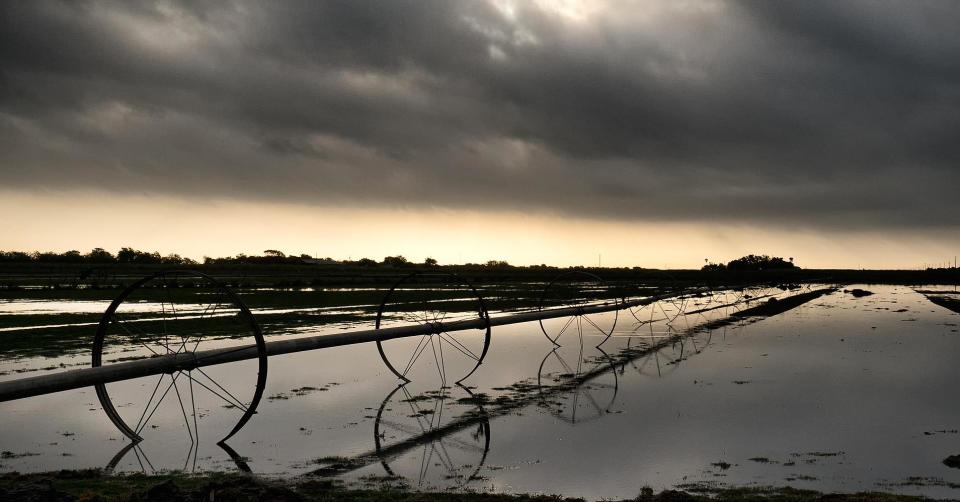
Texas’ farmers were among the first to applaud the rain that abruptly halted a grueling multiyear drought that had tormented the region.
But what began as a blessing has turned quickly into a disaster, as corn and wheat crops rot in flooded fields.
“I think it is not all farmers, but some farmers are looking at a total loss for this year,” said Mike Barnett, a spokesperson for the Texas Farm Bureau. “You have some situations where farmers had a bumper crop, and now they have next to nothing for the season.”
The downpour has doused Texas with 35 trillion gallons-about the amount it would take to cover the entire state in eight inches of water, according to NBC News.
Fields are either flooded or too muddy to work in, so crops left unharvested are deteriorating, resulting in lower-quality product that will bring less at market.
The 1,700 acres of winter wheat Ben Wible has on his farm in Sherman should have been pulled already, but he has stayed away as the rain continues to soak his fields. Forecasters are predicting more rain and flooding this weekend, Wible told CNBC.
“Every drop of rain we get now is detrimental to us now,” Wible said. (Tweet This)
The wheat on Jay Davis’ farm in North Central Texas has grown so tall it is beginning to fall over, and the grain is starting to sprout. Once wheat sprouts, it cannot be sold for human consumption, so Davis may have to sell what he can salvage as livestock feed. He won’t get as good a price for it, and he will have to compete with other feed crops such as corn. Moreover, there isn’t a lot of demand for livestock feed in his area, so he will have to weigh whether it’s worth the cost of transporting the grain elsewhere.
“We don’t know what the market for this crop is going to be, even if it is harvested,” Davis said.
The delayed wheat harvest could lead to bottlenecks all through that crop’s supply chain-the harvesting crews that go from farm to farm to help clear fields will have to rush, and there could be backups at local grain elevators and flour mills, Davis said. Those businesses aren’t pulling in the revenue they would normally expect at this point of the year either, and may have to do with reduced supply from local farmers this year.
“The key thing here is, even if this crop is harvested, we have disrupted the normal flow of harvest operations from south to north,” he said. “We are crowding the ability of those crews and machinery to move, because we are going to have a large area stretching across Texas into Oklahoma and other states that is going to be harvesting all at the same time. That is going to stretch the ability of the harvest crews to cover that acreage.”
Because the winter and early spring crops are still in the ground, farmers cannot plant their summer crops, so that season is delayed, as well. A lot of people could not plant their corn, Wible said.
Cotton farmers in Texas have planted just under a third of their intended crop for the year, according to the most recent U.S. Department of Agriculture data cited by Reuters. That is far less than the 47 percent they had in the ground at this time last year, and even further below the five-year average of 50 percent, according to Reuters.
And the corn that some have managed to get into the ground is suffering under the water. Too much water can stunt the crop and cause it to turn yellow; both conditions either reduce or eliminate its value, depending on the severity.
A lot of farmers are saying they may have to collect on federal crop insurance, but the deadline to apply for corn insurance is May 31, and many farmers are not ready to pull the trigger, according to Reuters.
While crop insurance will give many farmers the chance to start over next year, it will not cover all of their losses from this season.
“I have heard people say, ‘Well, at least you have crop insurance,’ ” Davis said. “Well, OK, but that’s like saying it’s OK to get into a car crash because you have auto insurance. All it does it mitigate losses. It is no way to profit or prosper.”
Moreover, Davis said the situation will likely saddle him with higher premiums next year.
Consumers will probably not feel much pain in their wallets from the losses in Texas-bad weather there will just create selling opportunities for growers elsewhere.
As for the Texans, many will salvage what they can and keep going.
“I have been farming almost my whole life, and it has been good to me,” Wible said. “We got through the drought, and we will get through this.”
http://finance.yahoo.com/news/texas-farmers-facing-total-loss-184631980.html

Turn off HAARP everywhere!!!!
Agreed. But good luck with that.
Not to mention of course of the wipe out of cantaloups from far west Texas–Coyanosa, Pecos, Crane/Grandfalls/Royalty/Rankin/etc., Fort Stockton area, as well as much of the cotton grown in the lower Permian Basin and below Pecos.
Too bad these farmers don’t have the money to pay off the Army Corps or (Geo)Engineers to get them to stop the God-forsaken Chemtrails! Or are the bioengineers at Monsatan trying to force these farmers to grow GMO cotton and cantaloupes?
CA is likely to experience similar losses soon… for the opposite reason.
Too bad we can’t sabotage these chemtrail planes to prevent them from taking off.